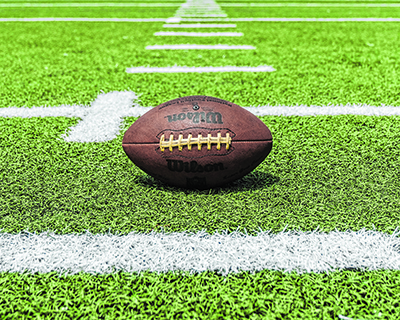Watching a Cowboys game earlier this season, I noticed an unusual disk-like object around the neck of Tony Pollard, Dallas’ star running back. Too thin and small to be a neck brace, it led me to Google, where I learned that it was a Q-Collar, a device designed to limit the risk of traumatic brain injuries (TBIs) among all athletes. Suddenly, the game became background noise as I did a deep dive into this product.
As I quickly discovered, Pollard wasn’t the only one sporting this sleek piece of hardware (around 40 NFL players currently wear it in games), and he wasn’t the first (Luke Kuechly first wore it in 2016). As we all know, helmets haven’t proven so successful in protecting players from brain injuries. This is because the helmet is designed to guard the skull. The Q-Collar’s sole purpose is to guard the brain. Q-collars are cerebrospinal fluid (CSF) pressure-enhancing collars —— lightweight and non-invasive devices that exert a gentle pressure that compresses the jugular veins. By restricting blood flow out of the brain, Q-Collars aim to increase the volume of cerebrospinal fluid, creating a protective cushion around the brain and reducing forces associated with head impacts.
Cerebrospinal fluid (CSF), a clear liquid surrounding the brain and spinal cord, plays a crucial role in protecting the central nervous system from impact-related injuries. When an athlete experiences a sudden blow or impact, the brain can shift inside the skull, leading to potential damage. Q-Collars work by supporting the brain within the protective cocoon of CSF, minimizing the risk of traumatic injury. Additionally, the collar contains an inflatable bladder that, when activated, applies mild pressure to the jugular veins. This pressure impedes the outflow of blood from the brain, facilitating the buildup of CSF around the neural tissues. By maintaining optimal CSF levels, Q-Collars reduce the brain’s vulnerability to concussive forces, offering a proactive approach to head injury prevention.
As Tony Pollard ran through the defense, seemingly with an extra layer of confidence, I thought of the larger implications of this device. This could revolutionize youth sports. Another Google search revealed that the FDA has approved the Q-Collar for athletes age 13 and over. So, why had I never heard of it? Why were high school athletes engaged in contact sports not wearing these? From what I’ve been able to gather, the answer is a lack of publicity. No one seems to be talking about it. When players make the team, they are handed pads and a helmet. I believe it’s time to seriously consider handing them a Q-Collar, too. Yes, these items can be costly, around $200 each, but it seems to be an invaluable investment.
One of the most significant advantages is the potential reduction of the severity of concussions, which are a growing concern for athletes on all levels. Chronic Traumatic Encephalopathy (CTE), a neurodegenerative disease linked to repeated head trauma, has raised significant alarms in the sports community, causing many parents to prohibit their children from even trying out. However, there may be a real solution, as studies have shown that athletes using Q-Collars experienced a lower rate of concussions compared to their counterparts who did not use the device. Q-Collars offer a proactive measure to minimize the cumulative effects of subconcussive hits, potentially safeguarding athletes from the consequences associated with CTE. Unlike some protective measures that may hinder performance or comfort, Q-Collars provide a discreet and convenient solution that integrates seamlessly into an athlete’s routine.
This contraption isn’t just helpful to football players but to any athlete playing a game where a head injury is a practical risk, including soccer and lacrosse.
The emergence of Q-Collars marks a significant step forward in sports medicine, offering a logical and promising way to reduce the impact of traumatic brain injuries on athletes. As the sports community continues to prioritize athlete well-being, it seems to be time to follow the lead of professionals like Tony Pollard, who says it has given him an “advantage on the field,” making him feel like he has “an extra layer of defense that most guys don’t have.” It’s time to give everyone this extra layer of defense.
—Submitted by Brandon Newman, 12th Grade Syosset student
Q-Collars: Revolutionizing Sports Safety and Concussion Prevention

(Image via Unsplash)






























